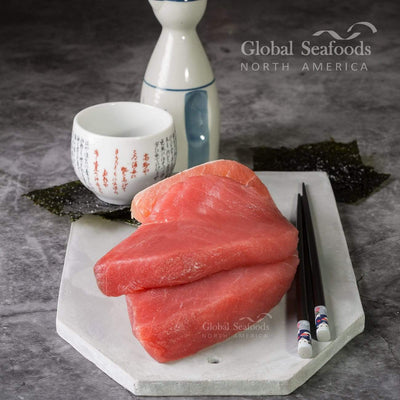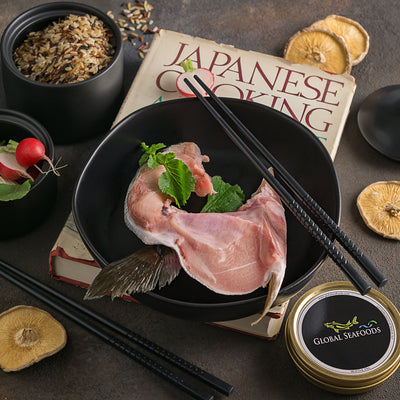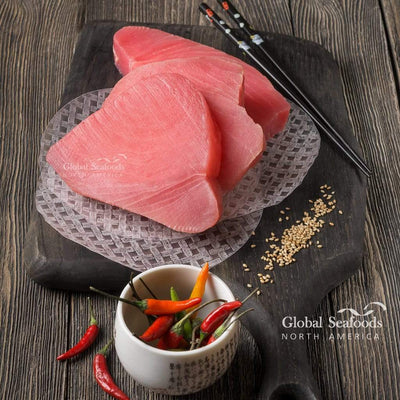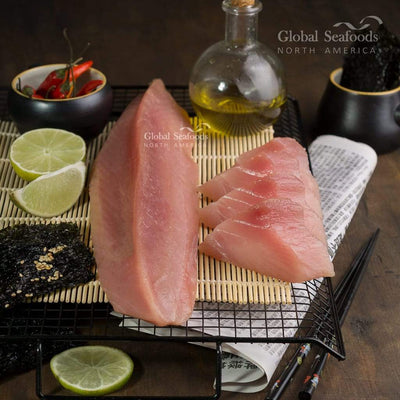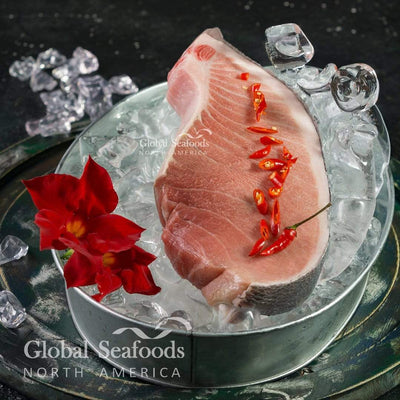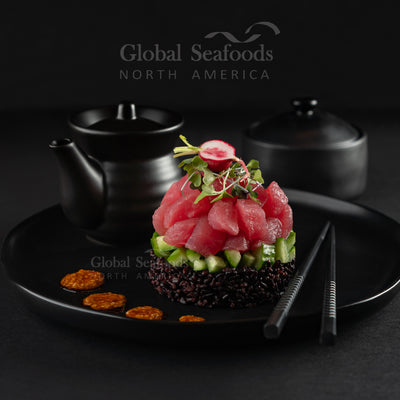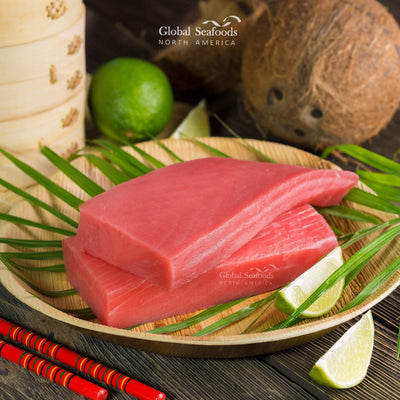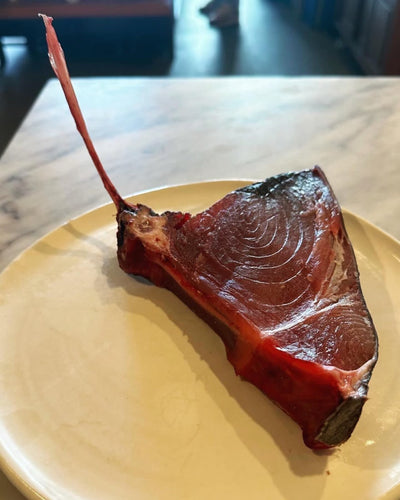Master the Art of Ahi Tuna with Miso Sauce and Asparagus

Ahi Tuna with Miso Sauce Recipe
Ahi Tuna, also known as yellowfin tuna, is one of the ocean’s finest offerings. Its versatility, nutritional profile, and delicate flavor make it a favorite for chefs and seafood enthusiasts worldwide. Let’s dive deeper into what makes Ahi Tuna so special, along with tips for selecting, storing, and cooking it.
What is Ahi Tuna?
A Versatile Delicacy
Ahi Tuna refers to the species of tuna called Thunnus albacares. It is widely used in both raw preparations like sushi and sashimi and cooked dishes like seared tuna steaks. Its texture is firm yet tender, with a mildly sweet flavor that absorbs marinades and spices beautifully.
Sustainability and Global Catch
Ahi Tuna is found in warm tropical and subtropical oceans, including the Pacific, Indian, and Atlantic. Many Ahi Tuna fisheries follow strict sustainability practices to preserve fish populations and protect the marine ecosystem. When purchasing tuna, always look for certifications such as MSC (Marine Stewardship Council) or FAD-Free labels to ensure sustainable sourcing.
Types of Tuna: How Does Ahi Compare?
Yellowfin Tuna (Ahi)
- Texture: Firm and lean, yet slightly tender.
- Flavor: Mild and sweet, making it perfect for marination and searing.
- Uses: Ideal for searing, sushi, poke bowls, and grilling.
Bluefin Tuna
- Texture: Rich and fatty with a buttery mouthfeel.
- Flavor: Intense and robust, prized in high-end sushi.
- Uses: Often reserved for sashimi or sushi due to its premium quality.
Bigeye Tuna
- Texture: Moderately fatty, perfect for grilling or baking.
- Flavor: Slightly more pronounced than yellowfin but less rich than bluefin.
- Uses: Works well for cooked recipes and hearty meals.
Nutritional Benefits of Ahi Tuna
Ahi Tuna is a nutritional powerhouse that caters to both health-conscious eaters and gourmet food lovers.
Nutrients in Ahi Tuna (per 3-ounce serving)
- Protein: 24 grams – excellent for muscle repair and growth.
- Calories: About 100 – a lean option for weight management.
- Omega-3 Fatty Acids: 350 mg – supports heart health, reduces inflammation, and enhances brain function.
- Vitamin D: Essential for bone health and immune function.
- Selenium: A powerful antioxidant that protects cells from damage.
- Low in Saturated Fat: Makes it heart-healthy without sacrificing flavor.
Selecting High-Quality Ahi Tuna
Key Indicators of Freshness
- Color: Look for bright, translucent red flesh. Avoid tuna with brownish or dull patches.
- Smell: Fresh tuna should have a clean, oceanic scent. Any fishy or sour odors are a red flag.
- Texture: The flesh should feel firm to the touch and not mushy.
Sushi-Grade Ahi Tuna
Sushi-grade tuna is specially handled to meet the rigorous safety standards required for raw consumption. It undergoes flash freezing at ultra-low temperatures to kill parasites while preserving its freshness. This makes it the perfect choice for dishes like sushi, poke, or seared tuna.
How to Store Ahi Tuna
Fresh Tuna
- Refrigeration: Keep fresh tuna in an airtight container or wrap it tightly in plastic wrap. Store it at 32°F (0°C) and use it within 24–48 hours for optimal flavor.
- Freezing: If you need to store tuna for a longer period, wrap it in freezer-safe packaging and freeze at -4°F (-20°C). Properly stored, it can last up to 3 months.
Thawing Tuna
- In the Refrigerator: Allow frozen tuna to thaw slowly overnight.
- Quick Thaw Method: Seal the tuna in a plastic bag and submerge it in cold water for 30–40 minutes. Avoid using warm water, as it can affect the texture.
Tips for Cooking Ahi Tuna
- Searing for Perfection: Ahi Tuna is best when seared over high heat for just 1–2 minutes per side. The goal is to create a golden crust while keeping the interior rare or medium-rare.
- Marinades and Rubs: Enhance the flavor with soy sauce, garlic, sesame oil, and citrus-based marinades. Dry rubs with black pepper and chili flakes also work beautifully.
- Pairing Flavors: The mild taste of Ahi Tuna pairs well with bold Asian-inspired flavors like wasabi, ginger, and miso.
- Cooking Temperature: For a perfect sear, ensure the pan or grill is preheated to high heat. A cold pan will cook the tuna unevenly and compromise its texture.
Creative Ways to Enjoy Ahi Tuna
- Poke Bowls: Combine diced raw Ahi Tuna with soy sauce, sesame oil, avocado, seaweed, and rice for a Hawaiian-inspired meal.
- Sushi and Sashimi: Thinly slice sushi-grade Ahi Tuna and serve with soy sauce, pickled ginger, and wasabi.
- Grilled Tuna Steaks: Marinate and grill tuna steaks for a smoky, hearty meal. Serve with grilled vegetables or a light salad.
- Tuna Tartare: Chop raw Ahi Tuna finely and mix with capers, lemon juice, and olive oil for a refined appetizer.
- Ahi Tuna Salad: Flake cooked tuna over greens, cucumbers, and tomatoes. Dress with balsamic vinaigrette or a light sesame dressing.
Sustainability in Tuna Fishing
Yellowfin Tuna populations are carefully managed to ensure long-term sustainability. Organizations like the Marine Stewardship Council (MSC) promote responsible fishing practices that minimize bycatch and habitat destruction.
When purchasing Ahi Tuna, choose suppliers committed to eco-friendly sourcing. Global Seafoods, for instance, ensures its tuna is sustainably harvested, providing you with premium quality while protecting the environment.
Shop High-Quality Ahi Tuna Online
Elevate your seafood experience with premium Ahi Tuna:
Chef Vlad’s Ahi Tuna recipe is a testament to the versatility and elegance of this extraordinary fish. Whether you’re searing it for dinner or slicing it raw for sushi, Ahi Tuna offers an unparalleled culinary experience. Explore its possibilities today!
Also in Video

How to Fillet, Skin & Pan-Fry Fresh Turbot — Chef Tips + Adjika Sauce Recipe
Discover how to turn a whole fresh turbot into a restaurant-quality dish. This guide covers filleting, skinning, trimming, pan-frying, and preparing sides like bok choy, potato scallops, and adjika sauce.

How to Make a Dry-Aged Ahi Tuna Sushi Roll at Home — Chef Joshua’s Step-by-Step Recipe
A complete recipe showing how to make a Dry-Aged Ahi Tuna Sushi Roll at home using Chef Joshua’s method: sliced tuna topper plus a spicy minced tuna filling. Includes step-by-step instructions and premium seafood recommendations.

How to Fillet Idiot Rockfish (Kinki) and Cook a Crispy-Skin Dinner With Wild Mushrooms & Ratatouille
Discover how to fillet Idiot Rockfish (Kinki) and prepare a crispy-skin seafood dinner with wild mushrooms and homemade ratatouille. Step-by-step instructions and chef-level tips.

